![]()
![]()
![]()
Use LEFT and RIGHT arrow keys to navigate between flashcards;
Use UP and DOWN arrow keys to flip the card;
H to show hint;
A reads text to speech;
19 Cards in this Set
- Front
- Back
|
Angiolipoma
1. S100 2. t(3;12) 3. Fat cells, and small capillaries 4. This lesion is painful |
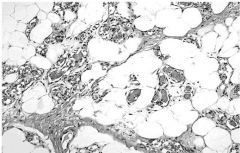
Recognize and answer :
1. Which IHC recation can be useful here ? 2. Which translocation is associated ? 3. What are the cell types present ? 4. What is special about this lesion ? |
|
|
Biphasic Synovial Sarcoma
1. EMA+ , S100+ 2. t(X;18) 3. Synovial sarcoma is part of the 'uncertain differentiation' 4. Affects Young adult Men more often 5. Cell types are Epithelial cells and Spindle cells 6. Foci of calcification may be present, and collagen bundles |
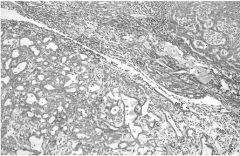
Recognize and answer :
1. IHC 2. Which translocation is associated ? 3. To which group of soft tissue tumors does this lesion belong to ? 4. What gender does it affect more ? What age ? 5. what are the cell types present ? 6. Special features ? |
|
|
Dedifferentiated Liposarcoma
1. S100+ 2. t(12;16) 3. Most common malignant soft tissue tumor in ADULTS 4. Occurs in deep tissue (abdomen..) 5. Consists of 2 components, a well differented liposarcoma and a high-grade non lipogenous sarcoma |
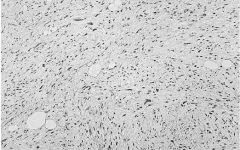
Recognize and answer :
1. IHC 2. Translocation ? 3. Frequency of tumor ? 4. What regions are affected ? 5. What are the constituents of this lesion ? |
|
|
Dermatofibrosarcoma Protubarance (DFSP)
1. Vimentin+, CD34+ 2. Affects the trunk and extremities of ADULTS 3. Spindle cells arranged in a STORIFORM pattern. 4. It is a tumor with an intermediate malignancy 5. It is a Fibrohistiocytic neoplasm |

Recognize and answer :
1. IHC 2. Affects which ages ? Which regions of the body ? 3. Microscopic pattern ? 4. What is its dignity ? 5. To which group of soft tissue tumors does it belong to ? |
|
|
Epitheloid Haemangioma
1. CD-34+, CD-31+, FXIII+ 2. Children 3. Head & Neck 4. Benign, Perivascular and Vessels |

Recognize and answer :
1. IHC 2. Age ? 3. Affects which regions ? 4. What is its dignity ? Which group does it belong to ? |
|
|
Fibromatoses
1. A fibrous tissue tumor 2. Mostly myofibroblasts 3. Shows an infiltrative growth pattern 4. Aggressive clinical behavior, local recurrences, but no metastasis |
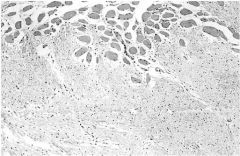
Recognize and answer :
1. To which group does this lesion belong to ? 2. What are the most common cell type ? 3. What is its pattern of growth ? 4. What is its clinical behaviour ? 5. Special features ? |
|
|
Fibrosarcoma
1. S100, EMA, Keratin, Desmin - all NEGATIVE 2. It is RARE 3. Affects extremities 4. Elongated spindle cells arranged in a hering-bone pattern |
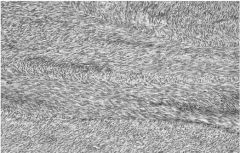
Recognize and answer :
1. IHC 2. Is it common ? 3. What region of the body does it affect ? 4. Microscopic pattern ? |
|
|
Genital Leiomyoma
1. Grossly its whitish gray, well circumscribed, firm mass 2. Eosinophilic smooth muscle cells, no mitotic activity, no necrosis 3. Uterine leiomyoma 4. Benign |
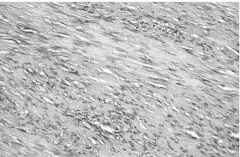
Recognize and answer :
1. What is its gross apperance ? 2. What is its microscopic appearance ? 3. Give an example for a specific location 4. Benign/malignant ? |
|
|
Granular cell tumor
1. S100+ 2. It is PAS+ 3. Belongs to the Peripheral nerves tumors/TLL 4. Small lesions, with ill defined borders 5. Large cells with granular cytoplasm 6. Benign |

Recognize and answer :
1. IHC 2. Special histological staining 3. Which group does it belong to ? 4. Gross apperance 5. Microscopic pattern 6. Benign/malignant |
|
|
High grade leiomayosarcoma
1. Alfa-smooth muscle actin+, Desmin+, Vimentin+ 2. rare 3. Fasicular pattern, with the tumor bundles intersecting each other in angles 4. Myxoid changes, giant cells |
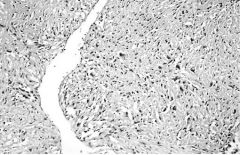
Recognize and answer :
1. IHC 2. Common/rare ? 3. Microscopic pattern 4. Special features |
|
|
Kaposi's Sarcoma
1. HHV-8 2. It is low-grade 3. Patch->Plaque->Nodular 4. Stromal hemorrhage and hemosidern deposition, and hyaline globules 5. It is a 'Vessels and perivascular cells' lesion |

Recognize and answer :
1. Virus associated with lesion ? 2. Is it low grade or high-grade ? 3. What are its morphological stages ? 4. Special features ? 5. What group does it belong to ? |
|
|
Malignant Peripheral Neuroectoderm
1. CD99+, NSE+ 2. Affects young adults 3. PAS+ 4. Also called Askin's Tumor |

Recognize and answer :
1. IHC 2. What age ? 3. Special histologic staining ? 4. Another name for it ? |
|
|
Monophasic Synovial Sarcoma
1. S100+, EMA+, CK's+ 2. t(X;18) 3. It is of an uncertain origin 4. Affects MALE young adults 5. Spindle cells |

Recognize and answer :
1. IHC 2. Which translocation is associated ? 3. To which group of soft tissue tumors does this lesion belong to ? 4. What gender does it affect more ? What age ? 5. what are the cell types present ? 6. Special features ? |
|
|
Myxoid Liposarcoma
1. S100+ 2. t(12;16) 3. Liposarcoma is the most common malignant soft tissue tumor in adults, and Myxoid liposarcoma is the most common Liposarcoma 4. Mucoid matrix, with chicken-wire pattern of capillaries |
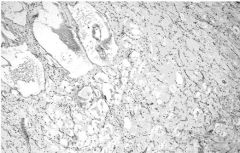
Recognize and answer :
1. IHC 2. Translocation ? 3. Is it common ? 4. Special features |
|
|
Nodular Fasciitis
1. It is neither benign, but it really is a TLL !! 2. Affects young adults, at the upper extremities 3. Shows infiltrative margins, spindle cells, mucoid matrix, large number of mitotic figures ! 4. Belongs to the fibrous tumors group of Soft tissue tumors |

Recognize and answer :
1. Is it benign/malignant ? 2. What age ? Location ? 4. Which group of Soft tissue tumors does it belong to ? 3. Special features |
|
|
Pleiomorphic Liposarcoma
1. S100+ 2. Malignant 3. High grade ! 4. Occurs in deep tissues, highly undifferentiated, shows giant cells |

Recognize and answer :
1. IHC 2. Is it benign or malignant ? 3. Is it low grade or high grade ? 4. Special features |
|
|
Rhabdomyosarcoma Embryonic
1. SMA-, Desmin+, MyoD1+, Vimentin+, Myoglobin+ 2. Most common malignant tumor of childhood 3. Affects head/neck/genitourinary/Extremities 4. Variants : Botryoid, Spindle cell, Anaplastic |

Recognize and answer :
1. IHC 2. Is it common ? 3. Which regions does it affect ? 4. What are its variants ? |
|
|
Rhabdomyosarcoma Embryonic
Rhabdomyosarcoma Embryonic 1. SMA-, Desmin+, MyoD1+, Vimentin+, Myoglobin+ 2. Most common malignant tumor of childhood 3. Affects head/neck/genitourinary/Extremities 4. Variants : Botryoid, Spindle cell, Anaplastic |

Recognize and answer :
1. IHC 2. Is it common ? 3. Which regions does it affect ? 4. What are its variants ? |
|
|
Round cell liposarcoma
1. S100+ 2. Liposarcoma is the most common malignant soft tissue tumor in adults, but nothing special about Round cell liposarcoma 3. Affects deep tissues 4. It is high grade 5. Small cells, acidophilic cytoplasm, vascular network not so prominent |

Recognize and answer :
1. IHC 2. Frequency 3. Location 4. Is it high grade or low grade ? 5. Microscopic features |

